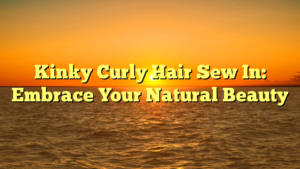Hair Texture and Type
Determining the texture and type of your hair is essential in order to choose the right hair extensions and hairstyles that will suit you best. Hair texture refers to the natural pattern or shape of your individual hair strands, while hair type refers to the overall characteristics of your hair such as thickness, density, and porosity.
There are generally four common hair textures: straight, wavy, curly, and kinky. Straight hair has a smooth and sleek appearance, often lacking in natural volume or body. Wavy hair, on the other hand, has a gentle S-shaped pattern, giving it a natural bounce and movement. Curly hair has a well-defined spiral or ringlet shape, and can range from loose to tight curls. Lastly, kinky hair is tightly coiled with a zig-zag pattern, often referred to as afro-textured hair. Understanding your hair texture can help you make informed decisions when it comes to choosing the right hair extensions or hairstyles that blend seamlessly with your natural hair.
Choosing the Right Hair Extensions
When it comes to choosing the right hair extensions, it is important to consider your hair texture and type. Different hair extensions work better with certain textures, so it is essential to match them accordingly. If you have fine, thin hair, you may want to opt for light and airy extensions that will blend seamlessly with your natural hair. On the other hand, if you have thick and coarse hair, you may prefer extensions with more volume and thickness to create a balanced look. By understanding your hair texture and type, you can select hair extensions that will enhance your overall appearance and provide a seamless blend.
Another factor to consider when choosing the right hair extensions is the desired length and style. Hair extensions come in various lengths, from short to long, and can be straight, wavy, or curly. It is essential to choose extensions that match the length and style you wish to achieve. Whether you want to add length, volume, or both, selecting extensions that align with your desired look will ensure a more natural and cohesive result. Additionally, consider the color and shade of the extensions. They should complement your natural hair color or blend well with any color changes you may have planned.
Benefits of Sew In Hairstyles
Sew in hairstyles offer a plethora of benefits for those looking to enhance their natural hair. One of the main advantages is the ability to add length and volume without causing any damage to the natural hair. Unlike other hair extension methods, sew ins are sewn into braided natural hair, eliminating the need for glue or heat-based application. This not only protects the hair from potential damage, but also allows for easy removal and reinstallation.
Additionally, sew in hairstyles provide versatility when it comes to styling options. From sleek and straight to bouncy curls, the added hair can be styled in various ways to achieve different looks. Whether you’re attending a special occasion or want a daily hairstyle that suits your personality, sew ins offer a wide range of possibilities. Moreover, they can be colored, cut, and styled just like natural hair, offering endless options for customization.
Tips for Proper Hair Care
To maintain healthy hair while wearing sew-in hairstyles, it is important to follow proper hair care techniques. First and foremost, avoid applying excessive heat to your hair. Heat styling tools such as straighteners and curling irons can cause damage and breakage to the hair strands. It is recommended to limit the use of these tools and opt for heatless styling methods whenever possible. Additionally, make sure to use a heat protectant spray before applying any heat to your hair to minimize potential damage.
Another important tip for proper hair care is to moisturize your hair regularly. Sew-in hairstyles can sometimes cause the natural hair to become dry and brittle due to the lack of exposure to natural oils. To combat this, use a good quality leave-in conditioner or hair oil to keep your natural hair hydrated. Applying the moisturizer to both the scalp and hair strands will ensure that your hair remains nourished and healthy throughout the duration of wearing the sew-in hairstyle.
Preparing Your Natural Hair for Sew In
Before getting a sew-in hairstyle, it is important to prepare your natural hair to ensure optimal results. The first step in this process is to thoroughly cleanse your hair and scalp. Use a gentle shampoo and conditioner to remove any buildup, dirt, or oils. It is crucial to start with a clean canvas to prevent any potential issues, such as scalp irritation or product buildup under the extensions.
After cleansing your hair, it is essential to detangle and trim your ends if necessary. This helps to ensure that your natural hair is in its best condition before the sew-in. Use a wide-tooth comb or a detangling brush to gently remove any knots or tangles. Remember to be gentle to avoid causing any damage to your strands. If there are any split or damaged ends, it is recommended to trim them off to prevent further breakage. By taking the time to prepare your natural hair properly, you are setting a solid foundation for a flawless sew-in hairstyle.
Different Sew In Techniques
Box braids and crochet hair are two popular sew-in techniques that give you versatility and a natural look. Box braids involve dividing your natural hair into individual sections and braiding synthetic or human hair extensions into each section. This technique allows you to create a variety of styles, from long and flowing braids to chic updos. On the other hand, crochet hair involves attaching pre-braided or pre-looped hair extensions to your natural hair using a crochet needle. This technique is quicker to install and provides a wide range of styling options, including curls, twists, and locs.
Another sew-in technique worth considering is the vixen sew-in. This method allows for multiple partings, giving you the flexibility to wear your hair in various styles. With the vixen sew-in, your natural hair is divided into four sections: two on the sides and two in the back. Extensions are then sewn in each section, allowing you to create different looks, such as updos, half-up, half-down styles, or simply wearing your hair down. The vixen sew-in is favored by those who desire more versatility and the ability to switch up their hairstyles frequently.
Maintenance and Upkeep
To ensure the longevity and beauty of your sew-in hairstyle, regular maintenance and proper upkeep are essential. One important aspect of maintenance is washing your hair and extensions regularly. It is recommended to wash your hair at least once a week with a gentle shampoo and conditioner. Be sure to thoroughly rinse out any product residue to prevent build-up. After washing, allow your hair to air dry or use a diffuser on low heat to minimize damage caused by heat styling tools.
In addition to washing, it is crucial to properly detangle your hair and extensions. Starting from the ends and working your way up, use a wide-tooth comb or your fingers to gently remove any knots or tangles. Avoid harsh pulling or tugging, as this can lead to breakage or damage to your natural hair. To maintain the integrity of your sew-in, it is recommended to avoid using excessive heat or styling products. Heat protectant sprays can be used to minimize damage when using heat styling tools, and lightweight oils or serums can be applied to add moisture and shine to your hair.
Styling Options for Sew In Hairstyles
One of the great advantages of sew-in hairstyles is the flexibility they offer when it comes to styling. With sew-in extensions securely attached to your natural hair, you can experiment with various hairstyles to suit your mood, occasion, or personal style. Whether you prefer sleek and straight, bouncy curls, or voluminous waves, sew-in hairstyles can be easily styled to achieve the desired look. Additionally, the added length and volume provided by the extensions allow for creative updos, braids, and ponytails, giving you even more styling options to explore.
Another popular styling option for sew-in hairstyles is color experimentation. With sew-in extensions, you have the freedom to try out different shades and highlights without the commitment of permanent dye. This allows you to rock vibrant colors or subtle, natural shades that complement your complexion and personal taste. Whether you want to go for a bold and daring look or add a touch of dimension to your natural hair color, sew-in hairstyles provide the perfect canvas for endless coloring possibilities. When it comes to styling options, sew-in hairstyles truly offer versatility and creativity.
How to Achieve a Natural Look
Achieving a natural look with sew in hairstyles is all about blending the extensions seamlessly with your natural hair. The key to achieving this is choosing hair extensions that closely match your hair texture and color. Opt for extensions made from human hair as they blend more naturally and can be styled to match your hair’s natural movement. It’s also important to choose extensions that are the right length and thickness, to ensure that they blend in seamlessly with your natural hair.
Once you have the right hair extensions, proper installation is crucial for achieving a natural look. Make sure that the extensions are securely sewn into your braided hair, with the stitching hidden from view. This will create a natural flow and ensure that the extensions stay in place. Additionally, consider using a closure or a frontal piece to mimic the appearance of a natural hairline. By paying attention to these details, you can ensure that your sew in hairstyle looks effortlessly natural and enhances your overall look.
Common Mistakes to Avoid
Many individuals new to wearing sew-in hairstyles often overlook the importance of proper installation. One common mistake to avoid is using excessive tension when braiding the hair. Pulling the hair too tightly can lead to scalp irritation, breakage, and even hair loss over time. It is crucial to ensure that the braids are secure but not overly tight, allowing for a comfortable and healthy foundation for the sew-in.
Another mistake to avoid is neglecting to care for your natural hair while wearing a sew-in. Although the extensions may add volume and length, it’s vital to remember that your natural hair still requires attention. Neglecting to moisturize and condition the hair properly can lead to dryness, breakage, and a lackluster appearance. Regularly deep conditioning and properly moisturizing your natural hair between sew-in installations will help maintain its health and vitality.



